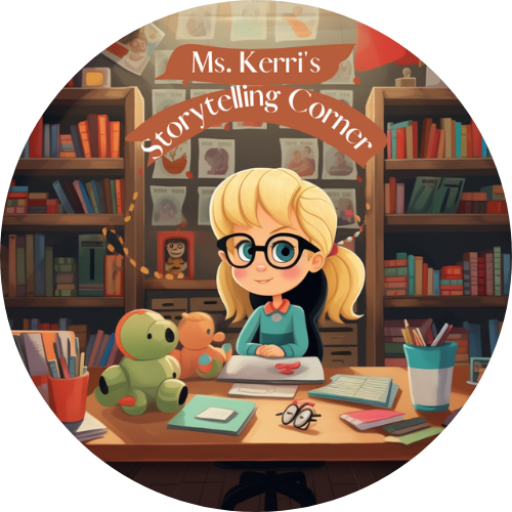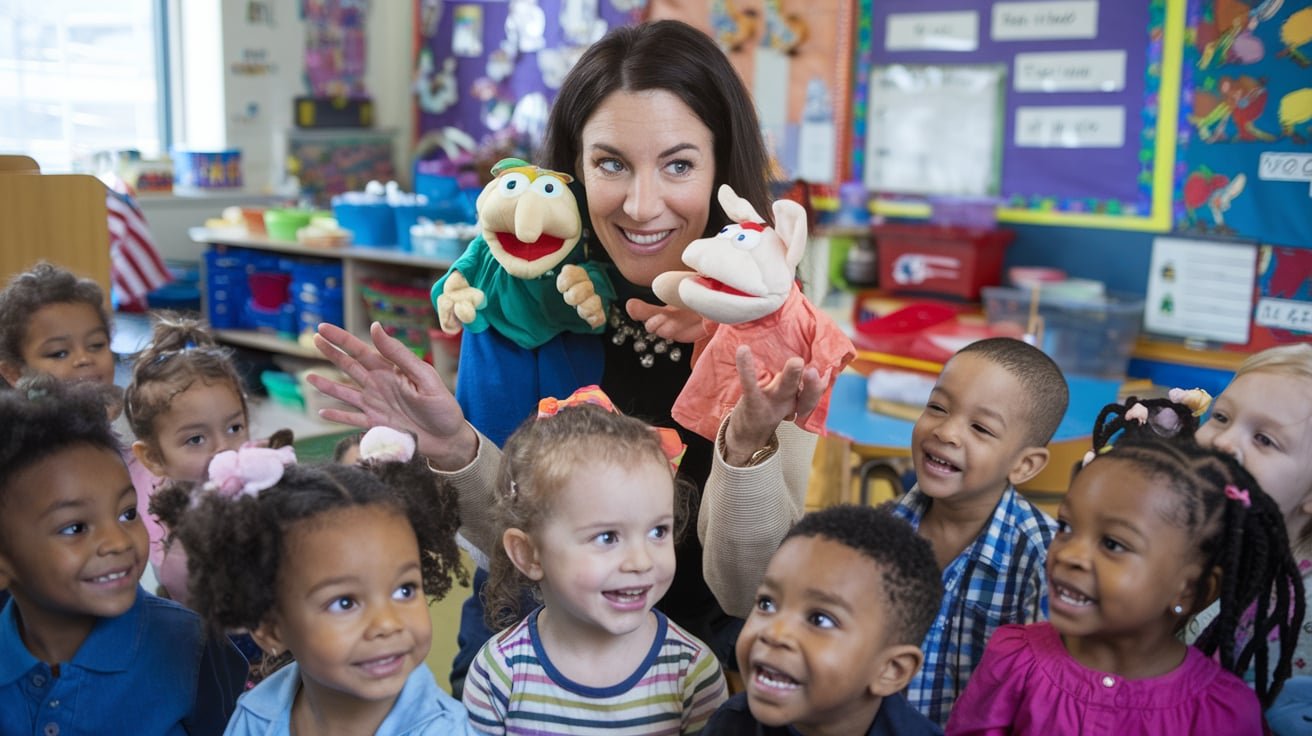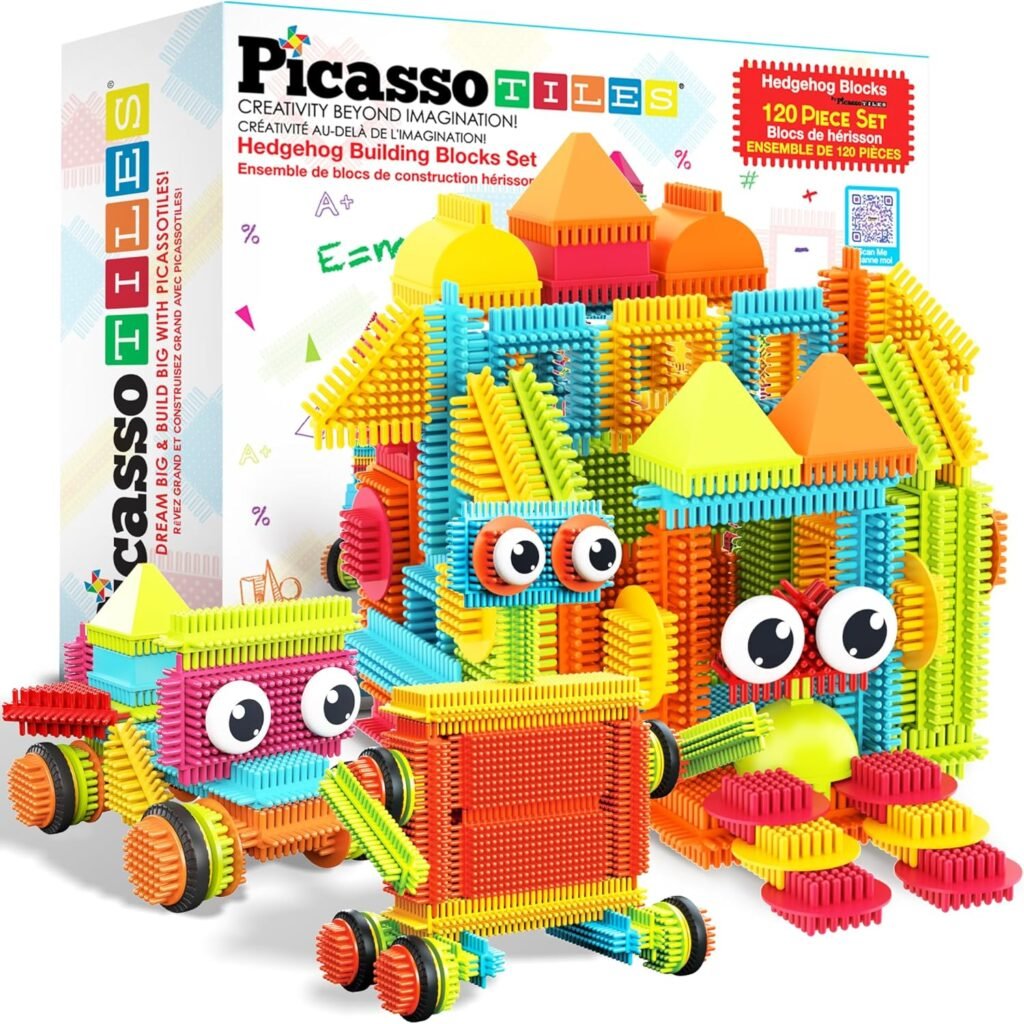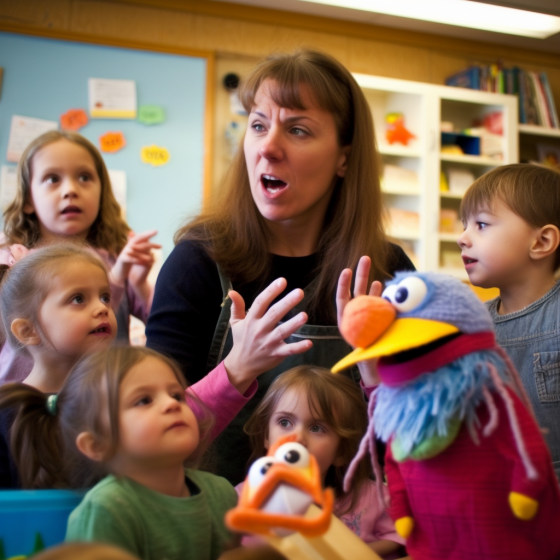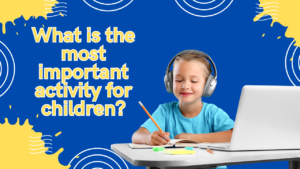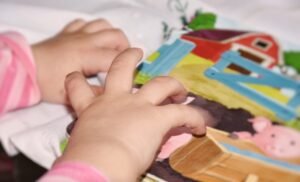Puppets are not just toys; they are powerful tools for teaching young children. In preschool education, puppets can capture attention and make learning enjoyable. They help kids express themselves, improve their language skills, and develop social abilities. This article explores the many benefits of using puppets in preschool settings and how they can transform learning experiences.
Key Takeaways
- Puppets engage preschoolers’ imagination and creativity, making learning fun.
- They help children express their feelings and build emotional connections.
- Using puppets can enhance language skills by encouraging kids to speak and tell stories.
- Puppets promote social skills through role-playing and conflict resolution.
- They are effective tools for classroom management, keeping students focused and engaged.
The Power of Puppets in Preschool Education
Puppets are a fantastic tool for teaching preschoolers. They can capture attention and make learning fun. Using puppets in the classroom can create a magical learning experience.
Engaging Young Minds Through Play
Puppets engage children in a playful way. They can:
- Spark imagination and creativity.
- Encourage participation in activities.
- Help children express their feelings.
Building Emotional Connections
Puppets can help children connect emotionally. They can communicate so much: from joy to sadness and make a real connection with people. This emotional bond can:
- Make children feel safe to share their thoughts.
- Help them understand their own feelings.
- Foster friendships among peers.
Enhancing Language Development
Puppets are great for improving language skills. They can:
- Encourage children to practice speaking.
- Help with pronunciation and vocabulary.
- Make storytelling exciting and interactive.
Puppets allow children to express themselves in a gentle way, making them feel comfortable in the classroom.
In summary, puppets are powerful tools in preschool education. They not only make learning enjoyable but also support emotional and language development.
How Puppets Improve Social Skills in Preschoolers
Role-Playing Everyday Scenarios
Puppets are fantastic tools for role-playing common situations that children encounter. By acting out these scenarios, kids can practice their social skills in a fun and engaging way. This method allows children to explore different perspectives and responses. Here are some examples of scenarios:
- Sharing toys
- Asking for help
- Saying sorry
Facilitating Conflict Resolution
Using puppets can help children learn how to resolve conflicts. When a puppet faces a problem, children can discuss how to solve it. This encourages them to think critically about their own interactions. For instance, they might:
- Identify the problem
- Suggest solutions
- Role-play the resolution
Encouraging Empathy and Understanding
Puppets can help children express their feelings and understand others’ emotions. When a puppet shows sadness or happiness, kids can learn to recognize and respond to those feelings. This builds empathy and helps them connect with their peers.
Engaging with puppets allows children to express emotions safely, fostering a supportive environment for social learning.
In summary, puppets are not just toys; they are powerful tools that can significantly enhance social skills in preschoolers. By using puppets, children can learn to navigate their social world with confidence and creativity.
Using Puppets to Enhance Language and Communication Skills
Practicing Oral Speaking Skills
Puppets provide a fun way for children to practice their oral speaking skills. When kids talk to puppets, they can express their thoughts freely. This interaction encourages them to articulate their ideas clearly. For example, a child might explain a story to a puppet, which helps them gain confidence in their speaking abilities.
Improving Pronunciation and Vocabulary
Using puppets can also help improve children’s pronunciation and vocabulary. When a puppet mispronounces a word, children can correct it, reinforcing their learning. Here are some ways puppets can enhance vocabulary:
- Introduce new words through puppet dialogues.
- Encourage children to use synonyms by having puppets ask for alternatives.
- Create scenarios where puppets use specific vocabulary in context.
Encouraging Storytelling and Sequencing
Puppets make storytelling exciting! Children can retell their favorite tales or create new ones with puppets. This practice helps them understand story structure and sequencing. Here’s how puppets can aid in storytelling:
- Act out different characters to make the story come alive.
- Use puppets to ask questions about the plot, prompting critical thinking.
- Encourage children to create their own stories, fostering creativity.
Puppets are not just toys; they are powerful tools for learning. They help children express themselves and develop essential language skills in a playful way.
In summary, puppets are a fantastic way to enhance language and communication skills in preschoolers. They create a safe space for children to practice speaking, improve their vocabulary, and engage in storytelling, making learning both effective and enjoyable. Puppets can truly transform the learning experience!
Creative Ways to Incorporate Puppets in the Classroom
Puppets can be a fantastic tool for making learning fun and interactive. They can transform ordinary lessons into exciting adventures! Here are some creative ways to use puppets in your classroom:
Using Puppets for Imaginative Play
- Allow students to create their own puppet characters.
- Encourage them to develop stories and scenarios.
- Let them perform their puppet shows in front of the class.
Integrating Puppets into Lesson Plans
- Use puppets to explain new concepts or topics.
- Have students read to the puppet, which helps them practice their literacy skills.
- Create puppet dialogues to explore different perspectives on a subject.
DIY Puppet-Making Activities
- Organize a puppet-making workshop where students can create their own puppets.
- Use simple materials like socks, paper bags, or felt.
- Encourage students to personalize their puppets with unique features.
Puppets not only engage students but also help them express their feelings and ideas in a safe environment. They can be a bridge to deeper understanding and creativity.
Incorporating puppets into your teaching can lead to a more dynamic and enjoyable learning experience. Remember, puppets can help students connect with the material in a way that traditional methods may not achieve!
The Role of Puppets in Classroom Management
Maintaining Student Attention
Puppets are a fantastic way to grab and hold the attention of preschoolers. When a puppet enters the room, the energy shifts! Children are naturally drawn to the playful nature of puppets, making it easier for teachers to engage them in lessons. Here are some effective strategies:
- Use puppets to introduce new topics.
- Have puppets remind students of classroom rules.
- Create puppet characters that represent different subjects.
Setting Behavior Expectations
Puppets can also help in teaching appropriate behavior. By acting out scenarios, puppets can model how to treat others with kindness and respect. This method allows children to visualize the behavior expected of them. For example:
- A puppet can demonstrate sharing during playtime.
- Another puppet can show how to ask for help politely.
- Use puppets to role-play conflict resolution.
Creating a Positive Learning Environment
Using puppets fosters a warm and inviting classroom atmosphere. They can ease tension and help children feel more comfortable. Puppets can be a calming presence, especially during stressful moments. Here’s how:
- Introduce a puppet to lighten the mood during a tough lesson.
- Use puppets to celebrate achievements, big or small.
- Encourage cooperative play by having puppets work together.
Puppets not only entertain but also teach valuable lessons about behavior and social skills. They create a safe space for children to express themselves and learn from each other.
In summary, puppets are powerful tools in classroom management. They help maintain attention, set behavior expectations, and create a positive learning environment, making them essential in preschool education.
Puppets as Tools for Emotional and Social Learning
Helping Children Express Emotions
Puppets are a fantastic way for kids to express their feelings. Using emotional hand puppets allows children to identify and share their emotions in a safe environment. They can act out different scenarios, helping them understand complex feelings like happiness, sadness, or anger.
Building Self-Confidence
When children interact with puppets, they often feel more comfortable speaking and sharing their thoughts. This can be especially beneficial for shy kids. By giving a voice to a puppet, they can express themselves without fear of judgment, which boosts their self-esteem.
Promoting Cooperative Play
Puppets encourage teamwork and collaboration among children. They can work together to create stories or solve problems, fostering a sense of community. Here are some ways puppets can promote cooperative play:
- Role-playing different characters in a story.
- Working together to resolve conflicts between puppet characters.
- Creating group performances where each child contributes a puppet.
Engaging with puppets not only makes learning fun but also helps children develop essential social skills that will benefit them throughout their lives.
In summary, puppets serve as powerful tools for emotional and social learning, helping children navigate their feelings and build connections with others.
The Benefits of Puppetry in Early Childhood Education
Supporting Cognitive Development
Using puppets in the classroom can significantly enhance cognitive skills. Research shows that puppets help children learn better by making lessons more engaging. They can help kids remember information and understand complex ideas through storytelling and role-play.
Enhancing Motor Skills
Puppetry also aids in developing fine motor skills. Children manipulate puppets, which improves their dexterity and hand-eye coordination. Here are some key benefits:
- Improved dexterity through puppet manipulation.
- Enhanced coordination as children control puppet movements.
- Increased balance while performing puppet shows.
Fostering Creativity and Imagination
Puppets encourage children to think creatively. They can create their own puppet characters and stories, which promotes imaginative play. This creativity can lead to:
- Unique storytelling experiences.
- Innovative character creation using various materials.
- Collaborative play with peers, enhancing social skills.
Engaging with puppets allows children to express themselves freely and explore their creativity in a fun way.
In summary, puppetry is a powerful tool in early childhood education, offering numerous benefits that support overall development. By incorporating puppets into learning, educators can create a more dynamic and effective educational environment. Puppets not only entertain but also educate!
Final Thoughts on Puppetry in Education
In conclusion, using puppets in teaching preschoolers is a fantastic way to make learning fun and effective. They grab kids’ attention and help them understand new ideas in a playful way. Puppets can also boost children’s confidence, making it easier for them to express themselves. They create a friendly atmosphere where kids feel safe to share their thoughts. Overall, puppets are not just toys; they are powerful tools that can enhance learning and help children grow emotionally and socially. So, if you want to make your lessons more engaging and memorable, consider adding puppets to your teaching toolkit!
Frequently Asked Questions
Why are puppets effective in teaching preschoolers?
Puppets grab kids’ attention and make learning fun. They help children connect with the material in a playful way.
How can puppets help with social skills?
Using puppets allows kids to role-play different situations, helping them understand how to interact with others and resolve conflicts.
What language skills can puppets improve?
Puppets encourage kids to practice speaking, expand their vocabulary, and tell stories, making language learning enjoyable.
What are some fun ways to use puppets in the classroom?
Teachers can use puppets for storytelling, create puppet shows, or even let kids make their own puppets for imaginative play.
How do puppets help with classroom management?
Puppets can capture students’ attention and remind them of rules in a fun way, making it easier to manage behavior.
What emotional benefits do puppets provide?
Puppets can help children express feelings, build confidence, and encourage teamwork during play.
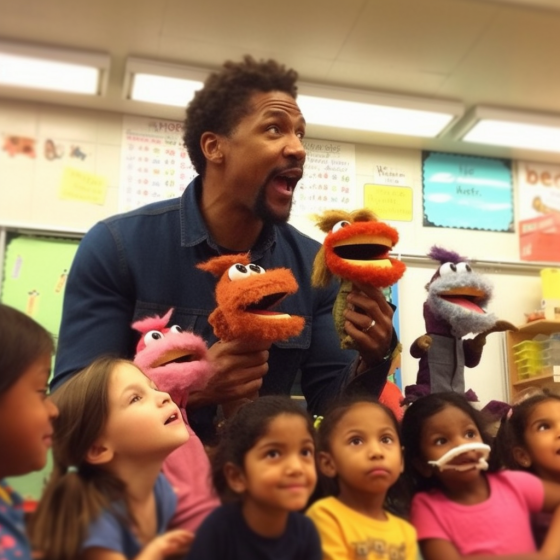

Ms. Kerri’s Corner provides a exciting virtual space for preschool learning. Through a variety of engaging activities, she exposes young minds to early math, literacy, science and social-emotional skills in a developmentally appropriate way. Centers for blocks, art, books and music allow children to explore hands-on learning at their own pace. Guided lessons subtly introduce number sense, letter sounds and narrative thinking. Careful observation gives insight into each child’s progress across domains. Viewers are also invited to participate, reinforcing that their ideas are valued. By making learning fun yet purposeful, Ms. Kerri lays the groundwork for future academic success while fostering creativity and imagination. Her program offers preschoolers valuable screen-based learning experiences.
